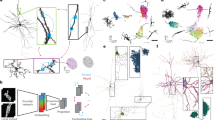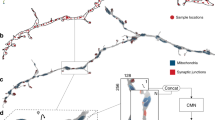Abstract
The reconstruction of neuronal populations, a key step in understanding neural circuits, remains a challenge in the presence of densely packed neurites. Here we achieved automatic reconstruction of neuronal populations by partially mimicking human strategies to separate individual neurons. For populations not resolvable by other methods, we obtained recall and precision rates of approximately 80%. We also demonstrate the reconstruction of 960 neurons within 3 h.
This is a preview of subscription content, access via your institution
Access options
Subscribe to this journal
Receive 12 print issues and online access
$259.00 per year
only $21.58 per issue
Buy this article
- Purchase on Springer Link
- Instant access to full article PDF
Prices may be subject to local taxes which are calculated during checkout



Similar content being viewed by others
References
Lichtman, J.W. & Denk, W. Science 334, 618–623 (2011).
Helmstaedter, M. & Mitra, P.P. Curr. Opin. Neurobiol. 22, 162–169 (2012).
Meijering, E. Cytometry A 77, 693–704 (2010).
Donohue, D.E. & Ascoli, G.A. Brain Res. Rev. 67, 94–102 (2011).
Li, A. et al. Science 330, 1404–1408 (2010).
Ragan, T. et al. Nat. Methods 9, 255–258 (2012).
Silvestri, L., Bria, A., Sacconi, L., Iannello, G. & Pavone, F. Opt. Express 20, 20582–20598 (2012).
Osten, P. & Margrie, T.W. Nat. Methods 10, 515–523 (2013).
Wang, Y., Narayanaswamy, A., Tsai, C.-L. & Roysam, B. Neuroinformatics 9, 193–217 (2011).
Wearne, S.L. et al. Neuroscience 136, 661–680 (2005).
Peng, H., Ruan, Z., Long, F., Simpson, J.H. & Myers, E.W. Nat. Biotechnol. 28, 348–353 (2010).
Türetken, E., Gonzalez, G., Blum, C. & Fua, P. Neuroinformatics 9, 279–302 (2011).
Zhao, T. et al. Neuroinformatics 9, 247–261 (2011).
Chothani, P., Mehta, V. & Stepanyants, A. Neuroinformatics 9, 263–278 (2011).
Lee, Y.-H., Lin, Y.-N., Chuang, C.-C. & Lo, C.-C. Neuroinformatics 12, 487–507 (2014).
Gala, R., Chapeton, J., Jitesh, J., Bhavsar, C. & Stepanyants, A. Front. Neuroanat. 8, 37 (2014).
Quan, T. et al. Sci. Rep. 3, 1414 (2013).
Helmstaedter, M., Briggman, K.L. & Denk, W. Nat. Neurosci. 14, 1081–1088 (2011).
Gillette, T.A., Brown, K. & Ascoli, G.A. Neuroinformatics 9, 233–245 (2011).
Brown, K.M. et al. Neuroinformatics 9, 143–157 (2011).
Bas, E. & Erdogmus, D. Neuroinformatics 9, 181–191 (2011).
Ming, X. et al. PLoS One 8, e84557 (2013).
Dijkstra, E.W. Numerische Mathematik 1, 269–271 (1959).
Xiong, H. et al. Nat. Commun. 5, 3992 (2014).
Zheng, T. et al. Opt. Express 21, 9839–9850 (2013).
Sholl, D.A. J. Anat. 87, 387–406 (1953).
Acknowledgements
We thank the members of the Britton Chance Center for Biomedical Photonics for advice and help in experiments. We also thank S.L. Hill and Y. Wang for suggesting Sholl analysis, as well as H. Peng and G.A. Ascoli for help with software usability and paper quality. This work is supported by the National Basic Research Program of China (grant 2011CB910401), the National Natural Science Foundation of China (grants 81327802 and 91432116), the Science Fund for Creative Research Group of China (grant 61421064), the National Key Scientific Instrument & Equipment Development Program of China (grant 2012YQ030260) and the the Director Fund of the Wuhan National Laboratory for Optoelectronics.
Author information
Authors and Affiliations
Contributions
S.Z. and H.G. conceived of the project. S.Z. and T.Q. designed the model and wrote the manuscript. T.Q. developed the algorithm. H.Z. wrote the software. J.L., H.Z. and S.L. performed image analysis and processing. A.L. and Y.L. constructed the computing platform for image preprocessing. S.Z., H.G., X.L. and Q.L. produced data. All authors revised the paper.
Corresponding authors
Ethics declarations
Competing interests
The authors declare no competing financial interests.
Supplementary information
Supplementary Text and Figures
Supplementary Figures 1–23, Supplementary Notes 1 and 2 and Supplementary Discussion (PDF 4305 kb)
Supplementary Software
NeuroGPS-Tree software (ZIP 46847 kb)
NeuroGPS-Tree_single tree
The manual reconstruction of a single neuron is faithful to the data set. (MOV 9752 kb)
NeuroGPS-Tree_slice
Maximum-intensity projections of a series of 3D image sections with the same thickness (10 μm) are used to show dense populations. (MOV 30863 kb)
NeuroGPS-Tree_Neuronal Population
Reconstruction of neuronal population from the image volume with NeuroGPS-Tree and individual neuronal trees are identified in different pseudo-colors. (MOV 26924 kb)
Rights and permissions
About this article
Cite this article
Quan, T., Zhou, H., Li, J. et al. NeuroGPS-Tree: automatic reconstruction of large-scale neuronal populations with dense neurites. Nat Methods 13, 51–54 (2016). https://doi.org/10.1038/nmeth.3662
Received:
Accepted:
Published:
Issue Date:
DOI: https://doi.org/10.1038/nmeth.3662
This article is cited by
-
Whole-mouse clearing and imaging at the cellular level with vDISCO
Nature Protocols (2023)
-
InstantTrace: fast parallel neuron tracing on GPUs
The Visual Computer (2023)
-
Hidden Markov modeling for maximum probability neuron reconstruction
Communications Biology (2022)
-
Deep learning enables reference-free isotropic super-resolution for volumetric fluorescence microscopy
Nature Communications (2022)
-
Brain-wide projection reconstruction of single functionally defined neurons
Nature Communications (2022)



